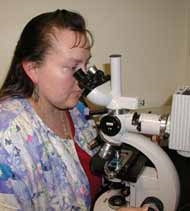Domestic rabies cases rare, but still a threat
 |
Kathi Wilson, a Colorado State University Veterinary Diagnostic Testing Laboratory technician, diagnosed the rabies in the Colorado puppy. Photo courtesy of CSU. |
Sometimes behind the face of innocence lurks danger. Recently, AAHA member Dr. Lawrence Giebel and his team learned firsthand just how deceiving looks could be.
On June 9, a woman brought an abandoned kitten into Giebel’s Quince Orchard Veterinary Hospital in North Potomac, Md., for treatment. She told the staff she had seen it thrown into the street from a pickup truck. The kitten was examined and appeared to be in good health except for a broken leg and an abrasion on its abdomen.
No one suspected that in 18 days they would be dealing with a case of rabies that would require the three veterinarians and nearly 20 staff members to make 675 phone calls and result in 51 people being treated for exposure to rabies.
The kitten remained at the Quince Orchard practice because its leg required recasting every other day. Friendly and adorable, the kitten soon became a popular attraction, said Dr. Giebel’s wife, Marilee Giebel, who helps manage the office. “All the clients (and their) children played pass the kitty for two weeks,” she said.
After 16 days, neurological symptoms prompted the veterinarians to send the kitten to a referral center. A neurologist recommended euthanasia, listing rabies as a potential diagnosis. On June 27, the tests came back positive.
“This type of rabies outbreak is rare in Montgomery County,” Dr. Giebel said. “It is the first case that I’ve encountered in almost 30 years of practicing medicine. None of my associates, including the veterinary neurologist who saw the kitten, has ever seen any domestic rabies cases—until now.”
More than 675 families, comprising nearly 1,000 people, had been through the clinic during the kitten’s 16-day stay. Letters from the hospital and the Montgomery County, Maryland, Department of Health and Human Services were mailed and phone calls made to all the hospital’s visitors.
Of those contacted, 92 people went through screening, which determined that 62 had been exposed. Eleven were staff members who had previously been inoculated, so 51 individuals underwent the postexposure series of vaccinations. The series costs approximately $1,000 per person, Marilee Giebel said.
The situation was a wake-up call, Marilee Giebel noted. “Rabies is such a complicated thing. We didn’t know how (the system) worked,” she said, adding that the public health department pretty much took over once the diagnosis was made. “We were lucky the health department was so generous. They could have killed our business.”
Marilee Giebel said the practice would be taking a hard look at a number of protocols, including pre-exposure vaccines, which cost approximately $400 per person. There are still a number of liability issues to be addressed.
A similar rabies case in Colorado was diagnosed Aug. 2 in a 10-week old puppy by the Colorado State University Veterinary Diagnostic Testing Laboratory.
Twenty-three people were required to undergo the postexposure treatment.
“Rabies in dogs is a rare occurrence in Colorado,” said Dr. Barbara Powers, director. “In fact, this is the first case in dogs since 1974, though we do get bats that are infected every year at the (CSU lab).”
Rabies information for both veterinarians and the public is available on the Centers for Disease Control website.



